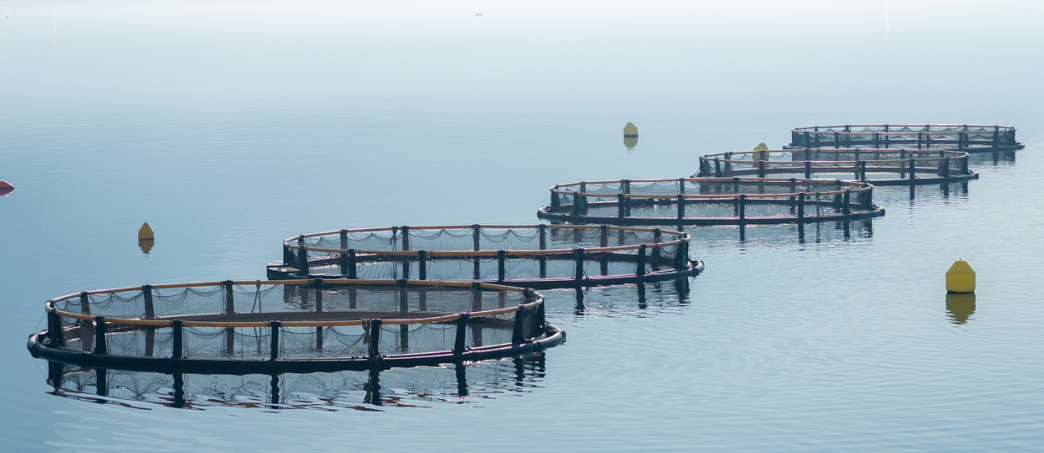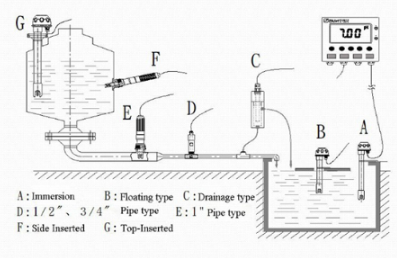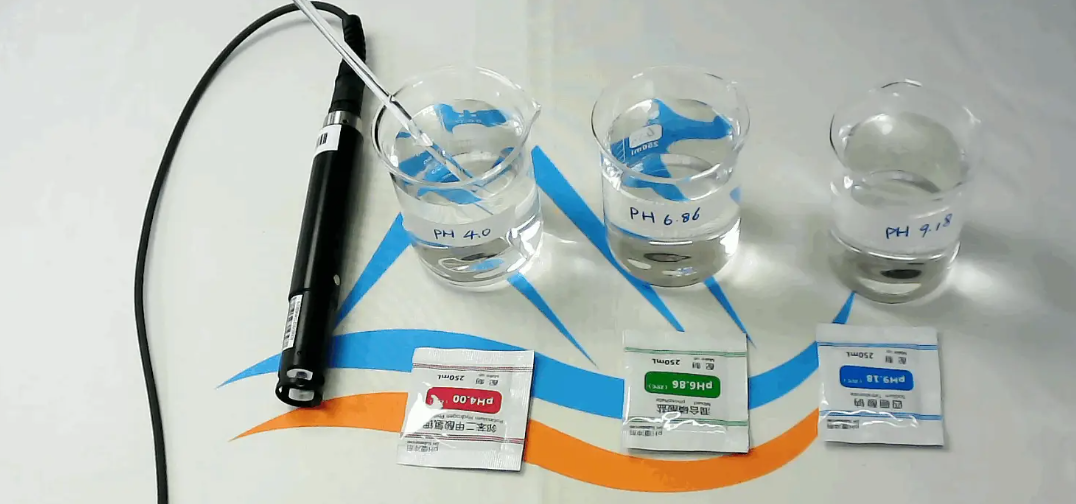The PH water quality sensor is a sensor used to detect the concentration of hydrogen ions in the measured object and convert it into the corresponding available output signal. It usually consists of a chemical part and a signal transmission part.
It is mainly based on the Nernst equation principle. A PH water quality sensor usually contains an electrode (usually a glass electrode) that is sensitive to hydrogen ions and a reference electrode. The potential of the glass electrode changes with the concentration of hydrogen ions in the solution, and the reference electrode provides a stable potential reference. By measuring the potential difference between these two electrodes, the PH of the solution can be calculated from Nernst's equation.
Sensitive electrode
Glass electrode is a common type of sensitive electrode. It has a special glass film that responds to changes in the concentration of hydrogen ions in solution. When the concentration of hydrogen ions in the solution changes, the charge distribution on both sides of the glass film changes, resulting in a change in the electrode potential
Reference electrode
Common reference electrodes are calomel electrode and so on. The role of the reference electrode is to provide a stable potential reference, whose potential is constant under certain conditions and is not affected by changes in the concentration of hydrogen ions in the solution. In this way, by measuring the potential difference between the glass electrode (indicating electrode) and the reference electrode, the change in the concentration of hydrogen ions in the solution can be accurately reflected, and then the pH value can be calculated.
Different electrodes are suitable for different scenarios. For example, the conventional composite electrode is suitable for non-corrosive weak acid and weak alkali environment; Planar desulfurization electrode is not easy to scale, easy to clean, suitable for desulfurization and other occasions; Ptfe electrode is suitable for strong acid, strong alkali, organic corrosion occasions; Electroplating electrode is suitable for sewage treatment, electroplating sewage fermentation, etc. Glass electrode is suitable for bioengineering, pharmaceutical and other places with a certain corrosion effect; The antimony electrode is strong and suitable for pH testing of hydrofluoric acid solution.

Environmental protection monitoring:
Real-time monitoring of pH changes in water, soil and other environments helps to assess the degree of environmental pollution and provides a scientific basis for environmental protection and governance.
Chemical production:
Used to monitor and control the pH of chemical reactions. By monitoring the pH of the reaction liquid in real time, the process parameters can be optimized and the product quality and yield can be improved.
Food processing:
Testing the pH of food, such as in the production process of beverages, yogurt and other products, strictly control the pH to ensure product quality and taste.
Pharmaceutical research:
Monitoring the pH of drugs and the pH balance of biological fluids helps to understand the pharmacological action of drugs and the physiological state of organisms, and provides help for drug research and development and medical diagnosis.
Water treatment and sewage treatment:
Monitoring the pH of water, by adjusting the pH of water, you can control the effect of water treatment and sewage treatment efficiency, to ensure that the water quality is up to standard discharge.
Agriculture:
Monitoring the pH of the soil, because the pH of the soil has an important impact on the growth of crops, by monitoring and controlling the pH of the soil, the yield and quality of crops can be improved.
Scientific research and education:
In chemical laboratories, biological laboratories and other places, to assist teaching and research work to help students and researchers understand the acid-base properties of solutions.
Online continuous monitoring of various water environment: such as rivers, lakes, groundwater, drinking water sources, industrial wastewater, etc., can timely discover the acid-base imbalance of water caused by natural factors or human activities, and provide accurate basis for relevant departments to formulate scientific and effective water pollution prevention and control measures.

Determine the installation location:
Generally, representative monitoring points should be selected, such as areas with uniform water flow and good mixing. If it is installed in a pipeline, choose a straight pipe section, away from elbows, valves and other parts that may affect the flow state.
For ease of maintenance and operation, the installation location should be relatively accessible and there should be sufficient space around to install and remove the sensor.
Threaded connection:
If the sensor has a threaded interface, it can be screwed directly into the pre-machined threaded hole. In the process of screwing, pay attention to moderate strength to avoid excessive force resulting in sensor damage. After tightening, ensure that the sensor is firmly installed and will not be loose.
Flanged connections:
For larger sensors or situations requiring a more robust installation, flanged connections can be used. Align the flange of the sensor with the flange of the mounting position and connect the two tightly by bolts. Pay attention to the sealing between the flanges when installing, and use a suitable sealing gasket to prevent water leakage.
Plug-in installation:
In some large diameter pipes or pools, plug-in installation can be used. Insert the sensor into the water through the mounting bracket, adjust the insertion depth to a proper position, and then secure the mounting bracket. Plug-in installation ensures that the measuring part of the sensor is completely submerged in water and will not be swayed by the impact of the current.
Cleaning frequency:
According to the use of the environment and water quality, it is generally cleaned every 1-2 weeks. If the water quality is poor or the sensor surface is easy to accumulate dirt, the cleaning frequency can be appropriately increased.
Inspection method:
Prepare a standard pH buffer solution, which is commonly used in pH 4.0, pH 6.86 and pH 9.18
Dip the sensor into a standard buffer solution and read the measured value according to the operating instructions of the sensor.

Short-term storage:
If the sensor is not being used temporarily (for a few days to a few weeks), it should be soaked in a suitable storage solution. It is generally possible to use 3mol/L of potassium chloride solution as a storage solution, soak the sensor in it, ensure that the electrode is completely submerged, and then seal the storage container and place it in a cool, dry place.
Mushroom cultivation requires a carefully contro
In today's fast-evolving agricultural landscape,
Coffee bean cultivation is highly dependent on s
Contact: Molly
Phone: +86-17775769236
Tel: 86-0731-85117089
Email: molly@codasensor.com
Add: Building S5, Aux Square, Yuelu District, Changsha City, Hunan Province, China
We chat